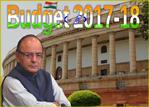
India's Finance Minister Arun Jaitley presented the budget for the fiscal year 2017-18 in the parliament on Wednesday, giving thrust to spending on rural areas and infrastructure to cushion the economy that experienced a slowdown due to the withdrawal of high denomination currency notes in circulation.
The country remains a "bright spot" in the world economic landscape, Jaitley said in his budget speech.
However, the three challenges in the current global scenario are the monetary stance of the U.S. Federal Reserve, uncertainty in commodity prices, especially crude oil, and the retreat from globalization.
The minister said that demonetization is a bold and decisive measure in a series of steps to arrive at new norm of bigger, cleaner and real GDP. He said the impact of demonetization is not expected to spill over into next year.
Jaitley said he firmly believes that the Goods and Services Tax, demonetization, JAM modes of identification will have an epoch-making impact on the lives of people.
The surplus liquidity in the banking system, created by demonetization, will lower borrowing costs and increase the access to credit, Jaitley said.
The government raised rural and agriculture spending and outlay for affordable housing ahead of assembly elections in key states.
With a better monsoon, the agriculture sector is forecast to expand 4.1 percent in the financial year 2017, he said. The minister pledged funds for agricultural credit and rural electrification.
Jaitley reduced the personal income tax rate for those belonging to lower tax slab, so as to boost disposable income after demonetization hit cash-based transactions.
In order to make good the loss caused by the reduction in tax rate, a 10 percent surcharge will be on the higher income group.
No transaction in excess of INR 300,000 will be allowed in cash from April 1, he said.
On the banking sector, the government proposed to recapitalize public sector banks and raised the allowable provision for non-performing assets to 8.5 percent.
Basic customs duty on LNG was reduced to 2.5 percent from 5 percent.
The current account deficit declined to 0.3 percent of gross domestic product in the first half of 2016-17 from about 1 percent last year, Jaitley added.
The fiscal deficit for 2017-18 was pegged at 3.2 percent and 3 percent for the financial year 2018-19. The revenue deficit was forecast to be 2.1 percent in 2016-17 before falling to 1.9 percent in the next year.
by RTT Staff Writer
For comments and feedback: editorial@rttnews.com
Business News

